People spend one-half of their lives in “less-than-good health,” we learn early in the paper, Adding years to life and life to years from the McKinsey Health Institute.
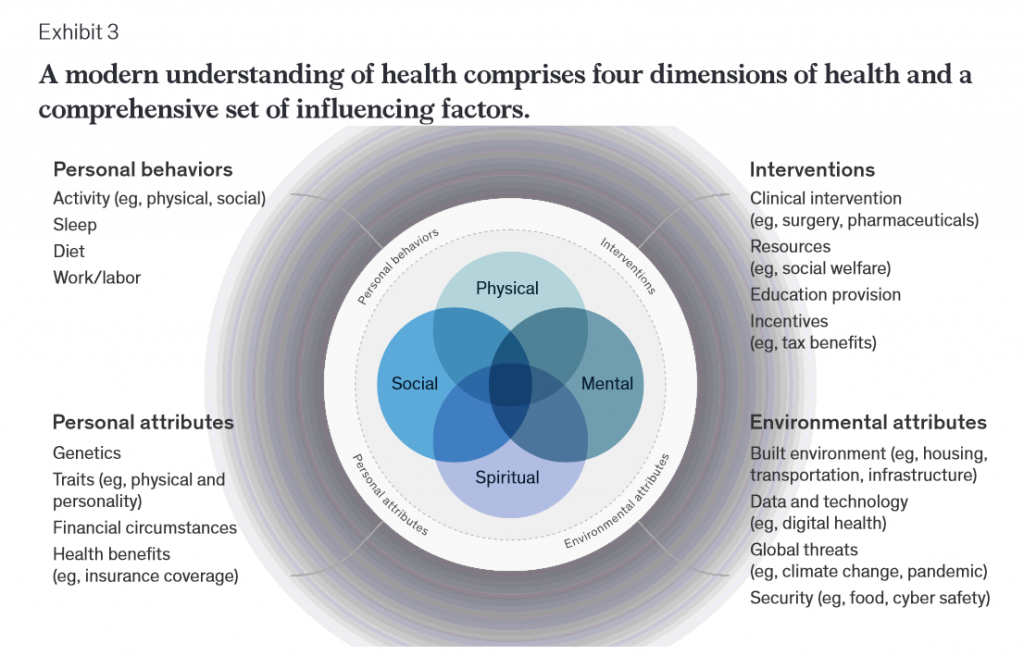 In this data-rich essay, the McKinsey team at MHI sets out an agenda that could help us add 45 billion extra years of higher-quality life equal to an average of six years per person (depending on your country and population demographics).
In this data-rich essay, the McKinsey team at MHI sets out an agenda that could help us add 45 billion extra years of higher-quality life equal to an average of six years per person (depending on your country and population demographics).
The first graphic from the report illustrates four dimensions of health and the factors underneath each of them that can bolster or diminish our well-being: personal behaviors (such as sleep and diet), personal attributes (like financial situation and genetics), interventions (e.g., health care treatments), and environment (such as climate and clean air and water, digitization, among other external factors).
MHI’s research into these areas convinced them that we have an opportunity to, in their words, “lift, square, and extend the curve” that maps the average course of human life in the next decade: that is,
- To lift or enhance the quality of life
- To square or improve the portion of life spent in good health, and
- To extend life expectancy, globally.
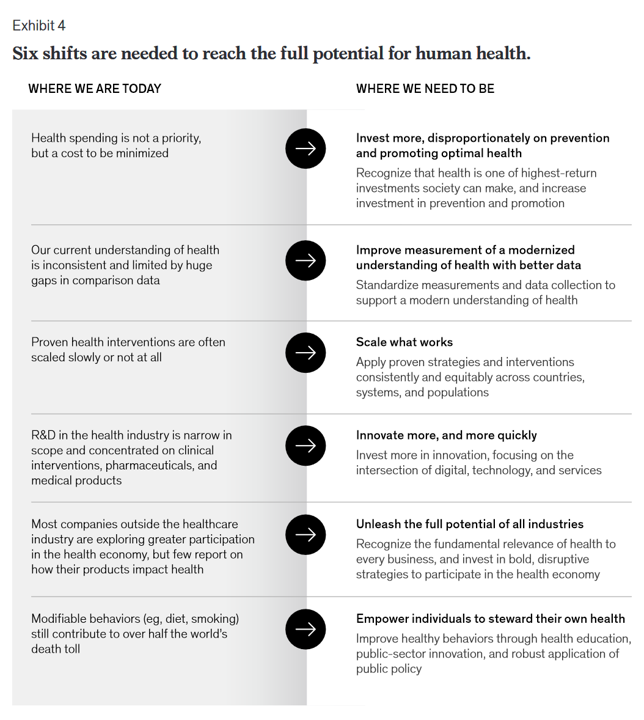 This led the team to identify six shifts that, implemented together, could add those 45 billion more years of quality life to extended life expectancy: those shifts are,
This led the team to identify six shifts that, implemented together, could add those 45 billion more years of quality life to extended life expectancy: those shifts are,
- To invest more and disproportionately on prevention and health promotion
- To improve measurement of a “modernized” understand of health, with better data and more holistically across the many dimensions that make health
- To scale what works, based on evidence and proven interventions — which depends on our reducing biases in our assumptions, models and strategies
- To innovate more, and more quickly, across the entire ecosystem of health — in government policies, pharmaceutical innovations, and technology developments
- To “unleash the full potential of all industries,” especially key for employers and organizations embracing environmental, social, and governance objectives (ESG) committed to supporting not just shareholders but community stakeholders: employees, local residents where companies operate, and the global community of (health) citizens; and,
- To empower people to steward their own health, enabling individuals to have more agency over their health and medical care.
Together, these six strategic shifts could improve the health of people around the world scaling evidence-based interventions and generating a return-on-investment two to four times just in terms of economic benefits.
As such, MHI concludes, health is “deeply relevant to all companies.”
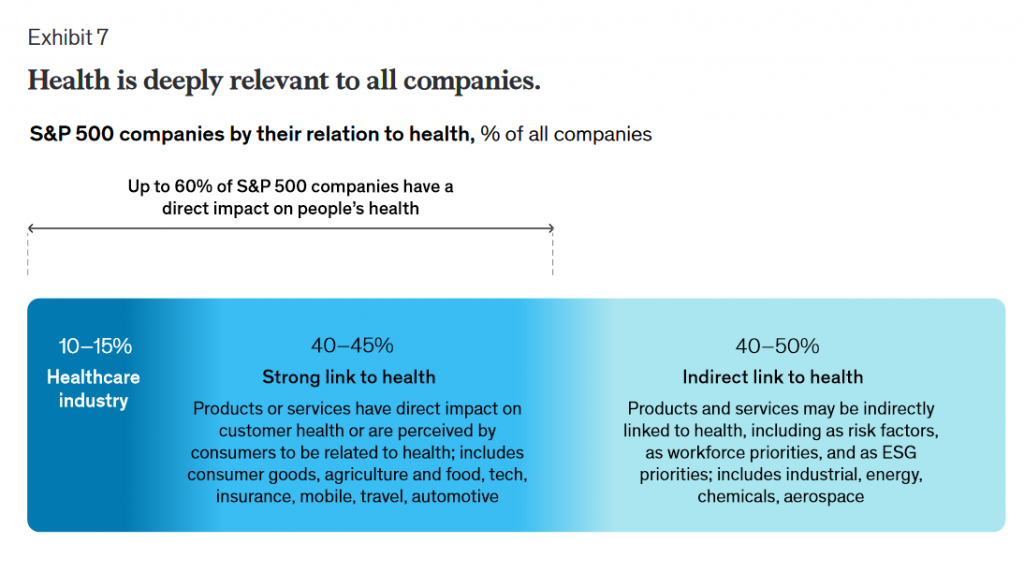 This is akin to our pointing out over the past years that every company is a health company. This graphic illustrates that about one-half of companies listed on the S&P have a direct impact on people’s health: think pharma, life sciences, medical technology, health insurance, food, and transportation.
This is akin to our pointing out over the past years that every company is a health company. This graphic illustrates that about one-half of companies listed on the S&P have a direct impact on people’s health: think pharma, life sciences, medical technology, health insurance, food, and transportation.
The other one-half of companies in the S&P have an indirect link to health — playing important roles in influencing human well-being in some way, through energy security, chemicals’ safety and efficacy, and other life-enhancing benefits.
This speaks to workers looking to their employers for health and well-being support and benefits, as well as to their good behavior in local and global communities for ESG commitments — for climate and environmental health, for diversity, equity and inclusion, for governance responsibility and oversight.
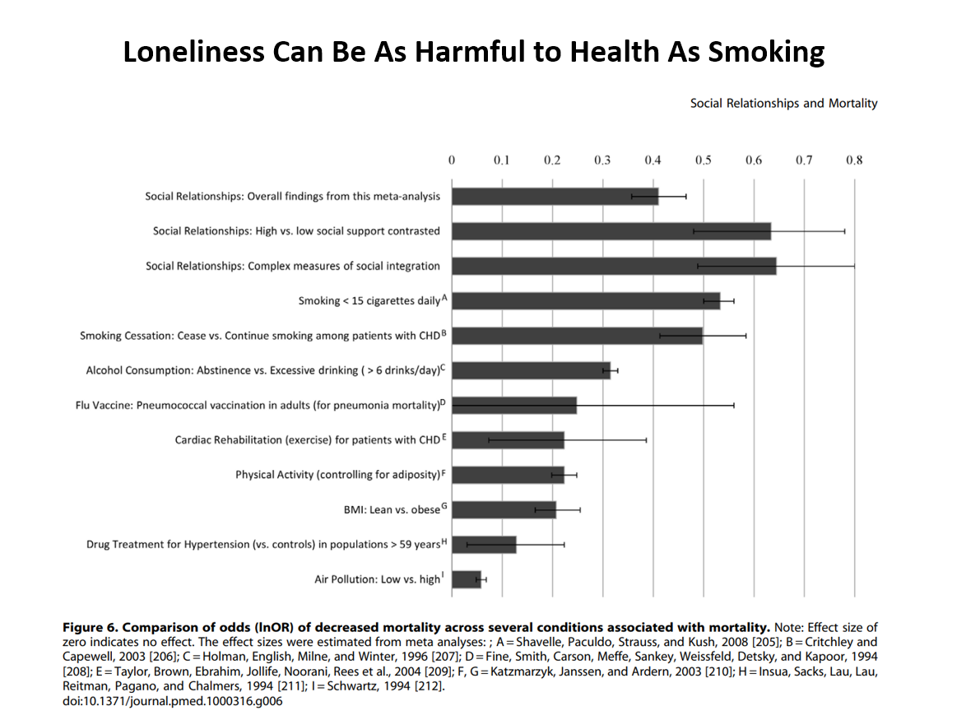 Health Populi’s Hot Points: Considering the double-whammy phenomena of the Deaths of Despair combined with the impact of deaths due to the coronavirus pandemic: the U.S. has seen a decline in life expectancy in the past few years that most other wealthy nations have not.
Health Populi’s Hot Points: Considering the double-whammy phenomena of the Deaths of Despair combined with the impact of deaths due to the coronavirus pandemic: the U.S. has seen a decline in life expectancy in the past few years that most other wealthy nations have not.
A key factor underpinning deaths of despair is social isolation and loneliness. And loneliness can kill us, we learned, from the study Social Relationships and Mortality Risk: A Meta-analytic Review, seminal research published in 2010 led by Julianne Holt-Lunstad and collaborators from Brigham Young University and University of North Carolina.
This research found that our social relationships are linked both to mental health as well as morbidity and mortality — that is, death.
The bar chart illustrates the result of the meta-analysis which considered 148 studies on mortality and risk factors. Here, we see that the risks of smoking 15 cigarettes a day on mortality (the fourth bar down from the top) ranked close to loneliness as a damaging factor on health and life.
The stark statistic the analysis calculated was that people with strong social bonds were 50% less likely to die over a given period of time than those who had fewer social connections.
So in addition to the six shifts McKinsey identifies as needed to reach the full potential for human health, I’ll add a seventh: the recognition and embrace that social connections bolster our health, well-being, and quality of life.
It’s the start of a new month, and a new spring season is emerging. It’s a fine time to go out and connect with a friend, a family member, a community human touchpoint at your faith institution, the Y, the coffee shop, or at school.
Doing so could add life to your own years, and years to your own life.


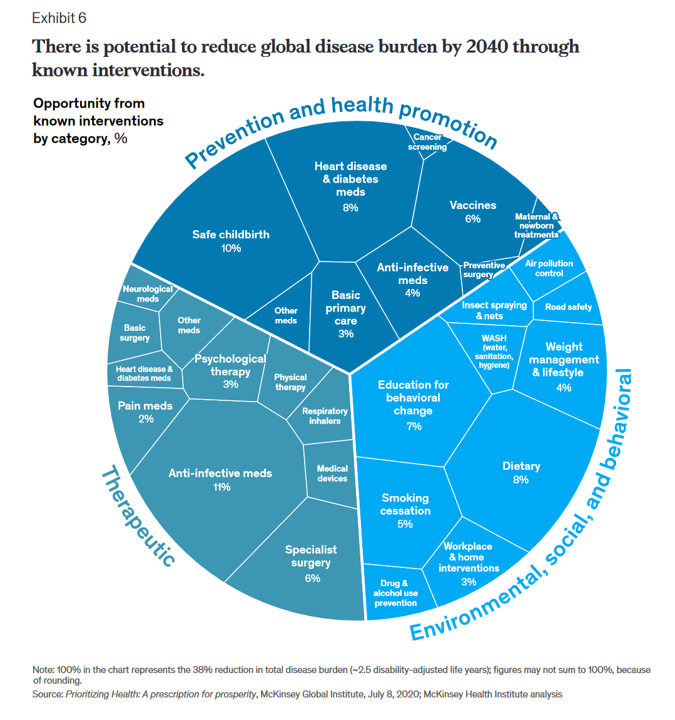


 Interviewed live on BNN Bloomberg (Canada) on the market for GLP-1 drugs for weight loss and their impact on both the health care system and consumer goods and services -- notably, food, nutrition, retail health, gyms, and other sectors.
Interviewed live on BNN Bloomberg (Canada) on the market for GLP-1 drugs for weight loss and their impact on both the health care system and consumer goods and services -- notably, food, nutrition, retail health, gyms, and other sectors. Thank you, Feedspot, for
Thank you, Feedspot, for  As you may know, I have been splitting work- and living-time between the U.S. and the E.U., most recently living in and working from Brussels. In the month of September 2024, I'll be splitting time between London and other parts of the U.K., and Italy where I'll be working with clients on consumer health, self-care and home care focused on food-as-medicine, digital health, business and scenario planning for the future...
As you may know, I have been splitting work- and living-time between the U.S. and the E.U., most recently living in and working from Brussels. In the month of September 2024, I'll be splitting time between London and other parts of the U.K., and Italy where I'll be working with clients on consumer health, self-care and home care focused on food-as-medicine, digital health, business and scenario planning for the future...